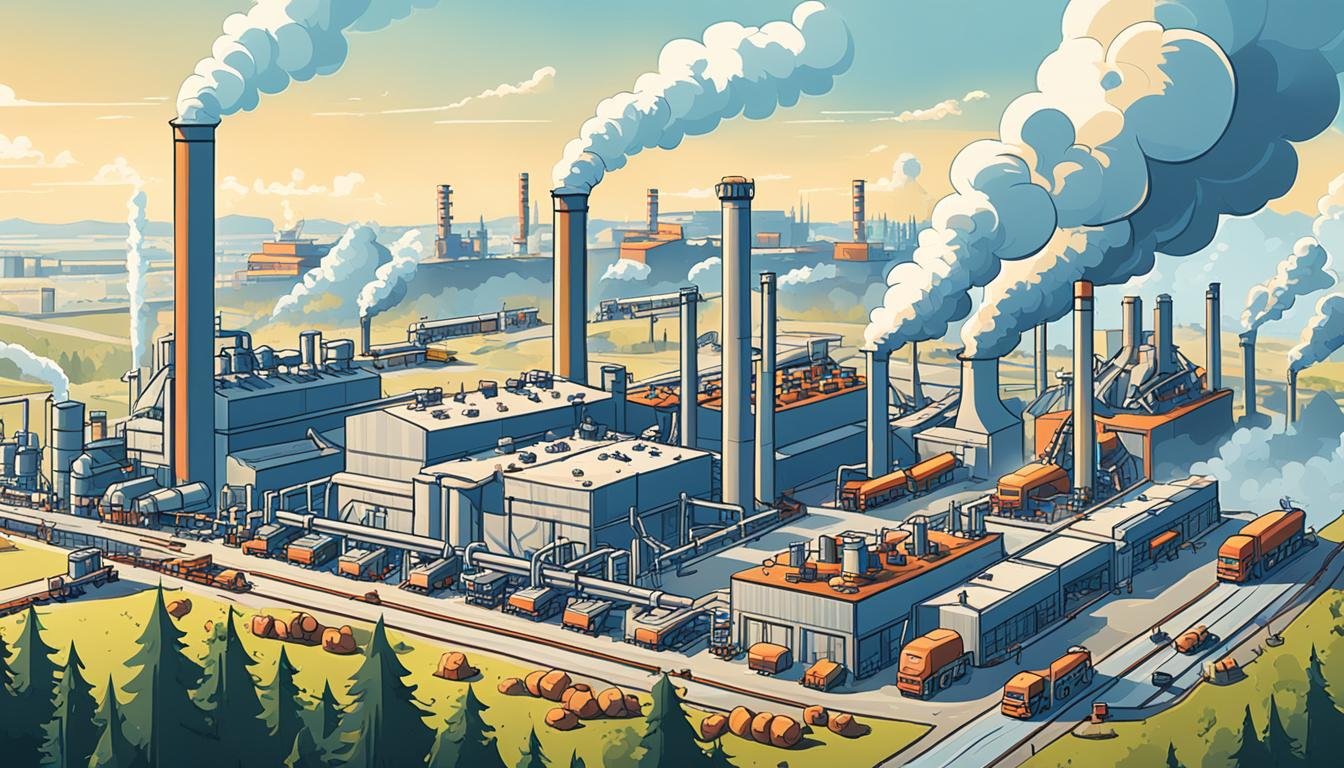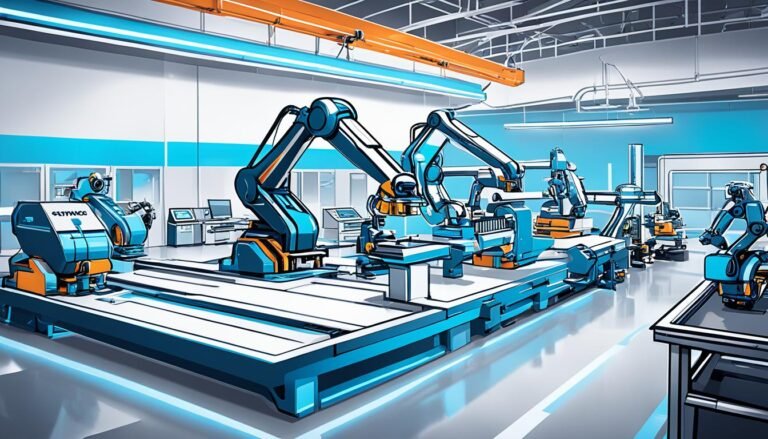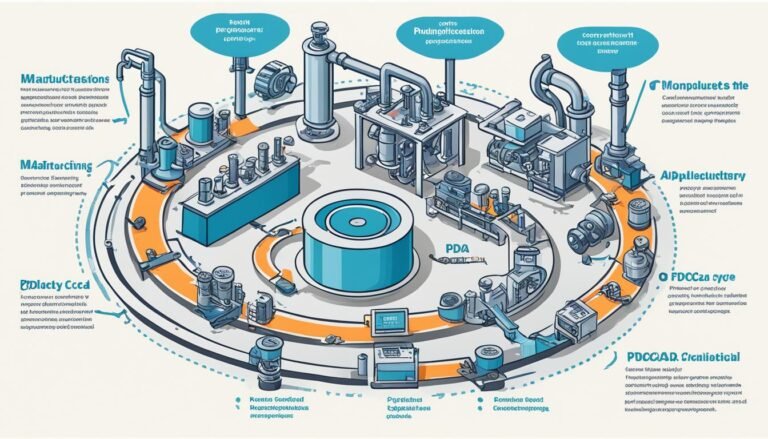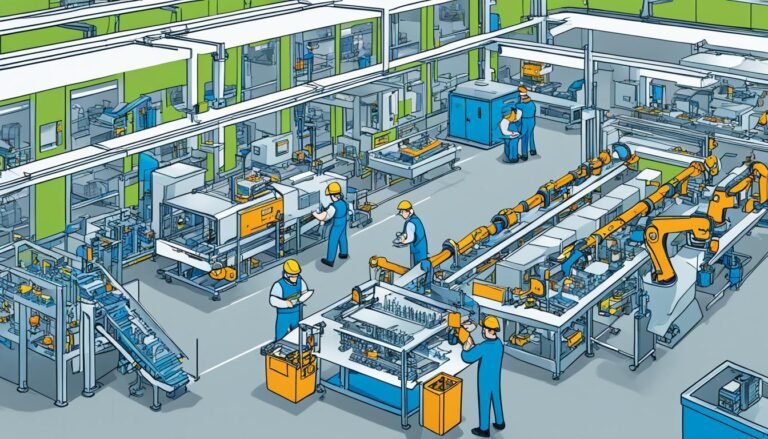Building Materials Manufacturing: Industry Insights
Did you know the building materials manufacturing industry is worth $1.5 trillion globally? This sector is key to our construction and economy. As we move towards sustainable development, making construction supplies in new ways is crucial.
Now, there’s a big move towards using materials that are low in carbon and save energy. This change is pushed by what customers want and laws that require it. The World Economic Forum talks about this big change. It shows we must use sustainable ways to make things and update how we produce them. This change is not just a trend; it’s vital for our planet and for keeping up with what the market wants.
Key Takeaways
- The global building materials manufacturing industry is valued at $1.5 trillion.
- Sustainable and innovative solutions in construction supplies are increasingly essential.
- Market trends are significantly shifting toward low-carbon and energy-efficient materials.
- The circular transition for sustainable development is gaining industry momentum.
- Modernization in production methods is necessary to address environmental impacts effectively.
- Regulatory pressures and consumer demand are driving the shift towards sustainability in the industry.
Overview of Building Materials Manufacturing
Building materials manufacturing is key to the global construction industry’s growth. As cities grow and nations update, the need for new, efficient, and green materials is huge. This sector is set to hit over USD 1.3 trillion by 2023, showing its big role in the market.
Introduction to the Industry
This industry makes many products crucial for building. Important items include aggregates, cement, bricks, and metals. It’s changing fast, with new smart tech to make things better and greener.
Key Market Segments
Several parts shape the building materials manufacturing industry:
- Raw Materials – Includes aggregates, cement, bricks, and metals.
- Advanced Technologies – Like 3D printing and materials that save energy.
These parts help drive the growth of the global construction industry.
Global Market Size and Projections
The trend of more cities is boosting this industry, thanks to smart city projects. The Asia Pacific region leads with almost half the market, due to fast city growth and big investments in infrastructure.
Also, using materials that are good for the planet is changing how things are made. New tech like 3D printing makes building faster and helps reduce waste.
Even with challenges like supply chain issues, tough rules, and environmental concerns, the outlook is bright. These issues make the building materials manufacturing sector a key part of today’s global construction world.
Raw Material Processing in Building Materials Manufacturing
The building materials industry uses many raw materials. It’s key to process these materials well to make quality construction materials. We’ll look at the types of materials, how they’re processed, and the challenges in this important step.
Types of Raw Materials
Construction materials come from many sources. You’ll find aggregates like sand, gravel, and crushed stone, and metals like steel and aluminum. Now, there’s a move towards sustainable materials like recycled plastic and fly ash. These materials are better for the planet.
Processing Techniques and Technologies
Processing methods for construction materials have gotten better. Crushing, grinding, and screening turn raw materials into what we need. Technologies like Building Information Modeling (BIM) help use materials better. They make things more efficient and cut down on waste.
Challenges in Raw Material Processing
Even with new tech, processing materials has its hurdles. Rules on emissions and waste disposal are big issues. Supply chain problems and the need for skilled workers can also affect quality. To fix this, the industry is using new tech and reforms supported by the government.
| Challenges | Solutions |
|---|---|
| Environmental Constraints | Adoption of Eco-friendly Technologies, Regulatory Compliance |
| Supply Chain Complexities | Optimized Logistical Operations |
| Skilled Labor Shortage | Training Programs, Recruitment Initiatives |
Production Equipment and Techniques
Advanced production equipment and automation are key in building materials manufacturing. The shift from old methods to tech-driven facilities is changing the industry. Let’s explore how modern technology is driving this change.
Modern Production Equipment
Advanced equipment is crucial for efficient and precise building materials manufacturing. These technologies boost productivity and cut down on waste.
Tools like CNC milling machines, automated mixers, and robotic arms ensure consistent quality, reduce human error, and enable large-scale production with minimal downtime.
Automation and Smart Manufacturing
Automation in construction is a big step forward in smart manufacturing. Digital systems manage production lines, track data in real time, and keep things running smoothly.
Manufacturing management compliance software helps ensure that operations meet regulatory standards while optimizing efficiency.
This automation makes processes more efficient, cuts down on mistakes, and keeps quality high.
Smart manufacturing uses the Internet of Things (IoT) and Artificial Intelligence (AI) for predictive maintenance and data-driven decisions. This makes production more flexible and quick to respond to market needs.
Innovative Manufacturing Techniques
Innovation is key in modern manufacturing. Additive manufacturing, or 3D printing, lets us make complex shapes with less waste. Tools like laser measuring tools ensure parts meet exacting standards. These advances improve material quality and open up new design and construction possibilities.
| Technique | Advantage |
|---|---|
| 3D Printing | Reduces material waste and enables complex designs |
| IoT Integration | Enhances real-time monitoring and data analysis |
| Robotic Automation | Increases precision and reduces human error |
| Laser Measuring Tools | Provides high accuracy and quality control |
Quality Control Measures in Building Materials Manufacturing
In the building materials industry, it’s key to have strict quality control. This ensures safety and makes customers happy.
Importance of Quality Control
Quality control keeps building materials safe, strong, and reliable. It helps companies follow the rules and avoid big problems. By testing and checking often, companies show they care about quality. This builds trust with customers.
Key Quality Control Standards
Following quality control standards is a must in the building materials world. Groups like the International Organization for Standardization (ISO) and ASTM International set the rules. These rules make sure materials are safe and work well.
Technologies for Quality Assurance
New technologies are changing how we check quality. Tools like advanced tests and real-time monitoring help check materials at every step. This makes sure quality is always checked, not just at the end.
Using the latest quality checking tools helps companies stay ahead. They can quickly follow new rules and keep up with the market.
Sustainable Practices in Building Materials Manufacturing
The building materials industry is now focusing more on being green. This change is due to growing environmental worries and strict laws. The use of eco-friendly materials and green building projects is getting more popular. Companies are working to cut down on carbon emissions by using energy-saving solutions and sustainable materials.
Improving how resources are managed and cutting down on waste is key. By using new technologies and smart ways of making things, companies are getting better at what they do. They’re also using more sustainable materials. For example, things like insulated concrete forms and insulation that doesn’t harm the environment are becoming more common.
Top companies are leading the way in green building projects. They set the standard for being environmentally responsible. These efforts meet legal standards and match what the market wants. So, the industry is changing for the better, making sustainable practices the new normal for building projects.







